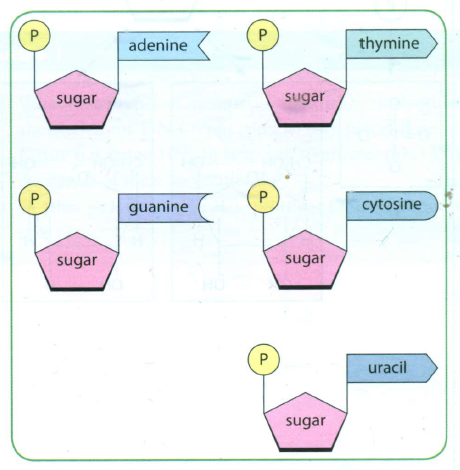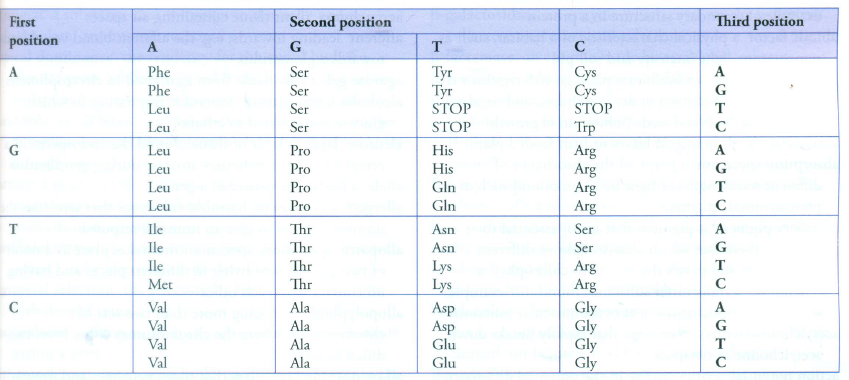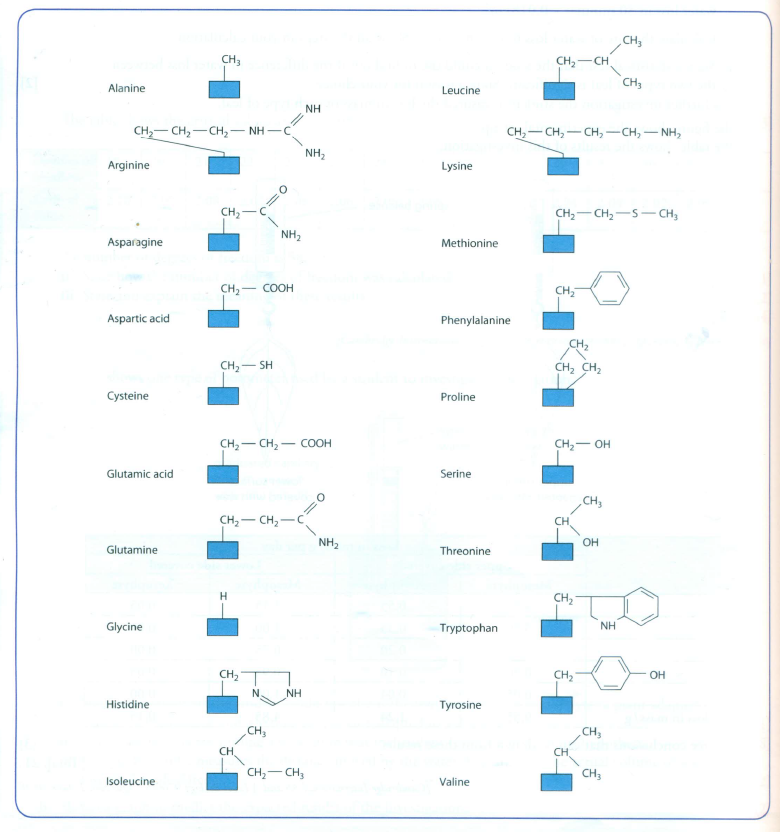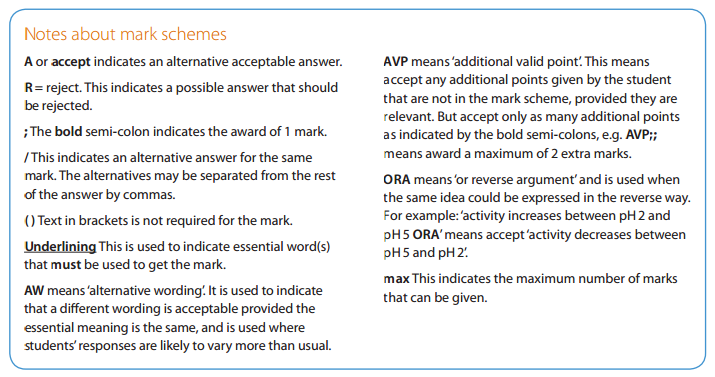Biology
 1. DNA and RNA are polynucleotides, made up of long chains of nucleotides.
1. DNA and RNA are polynucleotides, made up of long chains of nucleotides.
2. A nucleotide contains a pentose sugar, a phosphate group and a nitrogen-containing base. In RNA the sugar is ribose, and in DNA it is deoxyribose.
3. A DNA molecule consists of two polynucleotide chains, linked by hydrogen bonds between bases.
There are four bases ? adenine always pairs with thymine, and cytosine with guanine. RNA, which
comes in several diff erent forms, has only one polynucleotide chain, although this may be twisted
back on itself, as in tRNA. In RNA, the base thymine is replaced by uracil.
4. DNA molecules replicate during interphase by semi-conservative replication. Th e hydrogen bonds
between the bases break, allowing free nucleotides to fall into position opposite their complementary
ones on each strand of the original DNA molecule. Adjacent nucleotides are then linked, through their phosphates and sugars, to form new strands. Two complete new molecules are thus formed from one old one, each new molecule containing one old strand and one new.
5. The sequence of nucleotide bases on a DNA molecule codes for the sequence of amino acids in a polypeptide. Each amino acid is coded for by three bases. A length of DNA coding for just one polypeptide is a gene.
6. A change in the nucleotide sequence of DNA is a mutation, producing a new allele of the gene.
7. The DNA sequences for the HbA (normal) and HbS (sickle cell) alleles of the gene for the ?-globin
polypeptide diff er by only one base. Th e triplet CTT in HbA is replaced by CAT in HbS, changing
the amino acid glutamic acid to valine. This single diff erence in the polypeptide results in sickle cell
anaemia in individuals with two HbS alleles.
8. During protein synthesis, a complementary copy of the base sequence on a gene is made, by building a molecule of messenger RNA (mRNA) against one DNA strand. Th is stage is called transcription.
9. After transcription, the next stage is called translation. In this stage the mRNA moves to a ribosome in the cytoplasm. Transfer RNA (tRNA) molecules with complementary triplets of bases temporarily pair with base triplets on the mRNA, bringing appropriate amino acids. As two amino acids are held side by side, a peptide bond forms between them. The ribosome moves along the mRNA molecule, so that appropriate amino acids are gradually linked together, following the sequence laid down by the base sequence on the mRNA.
Multiple-choice Test
1 What is found in both DNA and messenger RNA (mRNA)?
A deoxyribose
B double helix
C sugar?phosphate chain
D thymine
2 In DNA extracted from rat bone marrow, 29% of the bases were found to be adenine.
What was the proportion of cytosine?
A 58%
B 42%
C 29%
D 21%
3 The diagram shows part of a nucleic acid.

What is represented by X?
A a base pair
B a nucleotide
C a polynucleotide
D a purine
4 Which statement about base pairing is not correct?
A Adenine can pair with either thymine or uracil.
B Thymine pairs only with adenine.
C Cytosine makes two hydrogen bonds with guanine.
D Purine bases only pair with pyrimidine bases.
5 Which statements describe RNA?
1 composed of phosphate, deoxyribose, adenine, cytosine, guanine and thymine
2 backbone is a ribose?phosphate chain
3 each molecule consists of two chains
4 consists of a chain of nucleotides linked through phosphates and sugars
A 1, 2 and 3 only
B 1 and 2 only
C 2 and 3 only
D 2 and 4 only
6 The diagram shows part of a DNA molecule before replication.

Which diagram shows a daughter molecule?
7 A single base substitution in the gene coding for the ?-globin polypeptide results in a change in the amino acid sequence.
Which statements describe what happens when haemoglobin containing polypeptides coded from the sickle cell allele, HbS, is not combined with oxygen?
1 The haemoglobin molecules are much less soluble.
2 The haemoglobin molecules form long fibres.
3 Red cells become distorted in shape.
4 Red cells become stuck in small capillaries.
A 1, 2, 3 and 4
B 1, 2 and 3 only
C 2 and 4 only
D 3 and 4 only
8 What is synthesised during transcription?
A DNA
B mRNA
C tRNA
D polypeptide
9 A mutation takes place in a DNA triplet coding for the amino acid tyrosine. The triplet ATA is changed to ATG.
The mRNA codons for tyrosine are UAU and UAC.
The mRNA codons signalling ?stop? are UAA, UAG and UGA.
What is the effect of the mutation?
A The mutated triplet codes for ?stop?.
B The mutated triplet codes for a different amino acid.
C The mutated triplet is meaningless.
D The mutated triplet still codes for tyrosine.
10 In most organisms, the mRNA codons signalling ?stop? in translation are UAA, UAG and UGA. In the microorganism Methanosarcina barkeri, UAG codes for an amino acid.
Which tRNA carrying an amino acid will be found in M. barkeri but not in most organisms?

Answers for Multiple - choice Test
1 C
2 D
3 B
4 C
5 D
6 B
7 A
8 B
9 D
10 C
End-of-chapter questions
1. What can be found in both DNA and messenger RNA (mRNA)?
A double helix structure
B sugar-phosphate chain
C ribose
D thymine
2. Which statement about base pairing in nucleic acids is not correct?
A Adenine can pair with either thymine or uracil.
B Guanine only pairs with cytosine.
C Thymine can pair with either adenine or uracil.
D Uracil only pairs with adenine.
3. How many different arrangements of four bases into triplets can be made?
A 3+4
B 3 x 4
C 34
4. Look at the structures of nucleotides in Figure below:

Draw a nucleotide that could be found:
a in either DNA or RNA
b only in DNA
c only in RNA.
5. Distinguish berween a nucleotide and a nucleic acid.
6. Copy the drawing and annotate it to explain the replication of DNA.

7. Use Appendix 1 to find the sequence of amino acids that is coded by the following length of messenger RNA (mRNA):
The table shows all the possible triplets of bases in a DNA molecule and what each codes for. The three-letter abbreviation for each amino acid is, in most cases, the first three letters of its full name - see Appendix 2.


8. The table shows all the messenger RNA (mRNA) codons for the amino acid leucine.
Copy the table and write in, for each codon, the transfer RNA (tRNA) anticodon that would bind with it and the DNA triplet from which it was transcribed.
9. In most people, the first six amino acids in their ?-globin polypeptide chains are:
Val-His-Leu-Thr-Pro-Glu-rest of chain
The DNA triplet coding for the sixth amino acid (Glu) in most people is CTT. In some people this
DNA triplet is CAT.
a What type of mutation is the change from CTT to CAT? [1]
b Use Appendix 1 to identify the amino acid in the ?-globin polypeptide chains of people with this mutation. [1]
c State the consequences for a person of having two copies of the mutated gene. [1]
10. Suggest why:
a a mutation in which one nucleotide of a triplet code is altered often makes no difference to the protein molecule coded by the DNA [2]
b the addition or deletion of three nucleotides in the DNA sequence of a gene often has less effect on the encoded protein than the addition or deletion of a single nucleotide. [4]
11. Copy and complete the following table to distinguish between the processes of transcription and translation.
12. The drawing shows polyribosomes.

a Name X, Y and Z. [3]
b In which direction are the ribosomes moving? Explain how you were able to decide on their direction of movement. [2]
[Total: 5]
End-of-chapter answers


- Translation
Translation is the process by which a triplet base sequence of mRNA molecules are converted into a specific sequence of amino acids in a polypeptide chain in the cytoplasm of a cell. It consists of initiation, elongation, and termination. The mRNA, a...
- # 36 Gene Mutation, Sickle Cell Anaemia
A gene mutation is a change in the sequence of nucleotides that may result in an altered polypeptide. A mutation is a random, unpredictable change in the DNA in a cell. It may be: ? a change in the sequence of bases in one part of a DNA molecule?...
- # 34 Dna Structurer And Replication
DNA molecule consists of nucleotides in which the sugar component is deoxyribose whereas the RNA molecule has nucleotides in which the sugar is a ribose. Nucleotides Roles: are monomers for nucleic acid polymers, such as DNA and RNA....
- # 33.2 Nucleic Acids And Protein Synthesis - Syllabus 2016
6.1 Structure and replication of DNA 6.2 Protein synthesis Nucleic acids have roles in the storage and retrieval of genetic information and in the use of this information to synthesise polypeptides. DNA is an extremely stable molecule that...
- # 33.1 Nucleic Acids And Protein Synthesis - Syllabus 2015
? Structure and replication of DNA ? Role of DNA in protein synthesis Learning Outcomes Candidates should be able to: (a) describe the structure of RNA and DNA and explain the importance of base pairing and the different hydrogen bonding between...
Biology
#37 Summary of Genetic control

2. A nucleotide contains a pentose sugar, a phosphate group and a nitrogen-containing base. In RNA the sugar is ribose, and in DNA it is deoxyribose.
3. A DNA molecule consists of two polynucleotide chains, linked by hydrogen bonds between bases.
There are four bases ? adenine always pairs with thymine, and cytosine with guanine. RNA, which
comes in several diff erent forms, has only one polynucleotide chain, although this may be twisted
back on itself, as in tRNA. In RNA, the base thymine is replaced by uracil.
4. DNA molecules replicate during interphase by semi-conservative replication. Th e hydrogen bonds
between the bases break, allowing free nucleotides to fall into position opposite their complementary
ones on each strand of the original DNA molecule. Adjacent nucleotides are then linked, through their phosphates and sugars, to form new strands. Two complete new molecules are thus formed from one old one, each new molecule containing one old strand and one new.
5. The sequence of nucleotide bases on a DNA molecule codes for the sequence of amino acids in a polypeptide. Each amino acid is coded for by three bases. A length of DNA coding for just one polypeptide is a gene.
6. A change in the nucleotide sequence of DNA is a mutation, producing a new allele of the gene.
7. The DNA sequences for the HbA (normal) and HbS (sickle cell) alleles of the gene for the ?-globin
polypeptide diff er by only one base. Th e triplet CTT in HbA is replaced by CAT in HbS, changing
the amino acid glutamic acid to valine. This single diff erence in the polypeptide results in sickle cell
anaemia in individuals with two HbS alleles.
8. During protein synthesis, a complementary copy of the base sequence on a gene is made, by building a molecule of messenger RNA (mRNA) against one DNA strand. Th is stage is called transcription.
9. After transcription, the next stage is called translation. In this stage the mRNA moves to a ribosome in the cytoplasm. Transfer RNA (tRNA) molecules with complementary triplets of bases temporarily pair with base triplets on the mRNA, bringing appropriate amino acids. As two amino acids are held side by side, a peptide bond forms between them. The ribosome moves along the mRNA molecule, so that appropriate amino acids are gradually linked together, following the sequence laid down by the base sequence on the mRNA.
Multiple-choice Test
1 What is found in both DNA and messenger RNA (mRNA)?
A deoxyribose
B double helix
C sugar?phosphate chain
D thymine
2 In DNA extracted from rat bone marrow, 29% of the bases were found to be adenine.
What was the proportion of cytosine?
A 58%
B 42%
C 29%
D 21%
3 The diagram shows part of a nucleic acid.

What is represented by X?
A a base pair
B a nucleotide
C a polynucleotide
D a purine
4 Which statement about base pairing is not correct?
A Adenine can pair with either thymine or uracil.
B Thymine pairs only with adenine.
C Cytosine makes two hydrogen bonds with guanine.
D Purine bases only pair with pyrimidine bases.
5 Which statements describe RNA?
1 composed of phosphate, deoxyribose, adenine, cytosine, guanine and thymine
2 backbone is a ribose?phosphate chain
3 each molecule consists of two chains
4 consists of a chain of nucleotides linked through phosphates and sugars
A 1, 2 and 3 only
B 1 and 2 only
C 2 and 3 only
D 2 and 4 only
6 The diagram shows part of a DNA molecule before replication.

7 A single base substitution in the gene coding for the ?-globin polypeptide results in a change in the amino acid sequence.
Which statements describe what happens when haemoglobin containing polypeptides coded from the sickle cell allele, HbS, is not combined with oxygen?
1 The haemoglobin molecules are much less soluble.
2 The haemoglobin molecules form long fibres.
3 Red cells become distorted in shape.
4 Red cells become stuck in small capillaries.
A 1, 2, 3 and 4
B 1, 2 and 3 only
C 2 and 4 only
D 3 and 4 only
8 What is synthesised during transcription?
A DNA
B mRNA
C tRNA
D polypeptide
9 A mutation takes place in a DNA triplet coding for the amino acid tyrosine. The triplet ATA is changed to ATG.
The mRNA codons for tyrosine are UAU and UAC.
The mRNA codons signalling ?stop? are UAA, UAG and UGA.
What is the effect of the mutation?
A The mutated triplet codes for ?stop?.
B The mutated triplet codes for a different amino acid.
C The mutated triplet is meaningless.
D The mutated triplet still codes for tyrosine.
10 In most organisms, the mRNA codons signalling ?stop? in translation are UAA, UAG and UGA. In the microorganism Methanosarcina barkeri, UAG codes for an amino acid.
Which tRNA carrying an amino acid will be found in M. barkeri but not in most organisms?

1 C
2 D
3 B
4 C
5 D
6 B
7 A
8 B
9 D
10 C
End-of-chapter questions
1. What can be found in both DNA and messenger RNA (mRNA)?
A double helix structure
B sugar-phosphate chain
C ribose
D thymine
2. Which statement about base pairing in nucleic acids is not correct?
A Adenine can pair with either thymine or uracil.
B Guanine only pairs with cytosine.
C Thymine can pair with either adenine or uracil.
D Uracil only pairs with adenine.
3. How many different arrangements of four bases into triplets can be made?
A 3+4
B 3 x 4
C 34
4. Look at the structures of nucleotides in Figure below:

a in either DNA or RNA
b only in DNA
c only in RNA.
5. Distinguish berween a nucleotide and a nucleic acid.
6. Copy the drawing and annotate it to explain the replication of DNA.

7. Use Appendix 1 to find the sequence of amino acids that is coded by the following length of messenger RNA (mRNA):
AUGUUUCUUGAUUAA
The table shows all the possible triplets of bases in a DNA molecule and what each codes for. The three-letter abbreviation for each amino acid is, in most cases, the first three letters of its full name - see Appendix 2.
Appendix 1
DNA triplet codes

Appendix 2
Amino acid R groups

8. The table shows all the messenger RNA (mRNA) codons for the amino acid leucine.
Copy the table and write in, for each codon, the transfer RNA (tRNA) anticodon that would bind with it and the DNA triplet from which it was transcribed.
mRNAcodon | tRNA anticodon | DNA triplet from which mRNA was transcribed |
UUA | ||
UUG | ||
CUU | ||
CUC | ||
CUA | ||
CUG |
1 2 3 4 5 6
Val-His-Leu-Thr-Pro-Glu-rest of chain
The DNA triplet coding for the sixth amino acid (Glu) in most people is CTT. In some people this
DNA triplet is CAT.
a What type of mutation is the change from CTT to CAT? [1]
b Use Appendix 1 to identify the amino acid in the ?-globin polypeptide chains of people with this mutation. [1]
c State the consequences for a person of having two copies of the mutated gene. [1]
[Total: 3]
10. Suggest why:
a a mutation in which one nucleotide of a triplet code is altered often makes no difference to the protein molecule coded by the DNA [2]
b the addition or deletion of three nucleotides in the DNA sequence of a gene often has less effect on the encoded protein than the addition or deletion of a single nucleotide. [4]
[Total: 3]
11. Copy and complete the following table to distinguish between the processes of transcription and translation.
Transcription | Translation | |
site in cell where process occurs | ||
molecule used as a template in process | ||
molecule produced by process | ||
component molecules used in process | ||
other molecules that are essential for the process to occur |

a Name X, Y and Z. [3]
b In which direction are the ribosomes moving? Explain how you were able to decide on their direction of movement. [2]
[Total: 5]
Organism (tissue) | Relative numbers of bases | |||
A | C | G | T | |
Ox (spleen) | 27.9 | 20.8 | 22.7 | 27.3 |
Ox (thymus) | 28.2 | 21.2 | 21.5 | 27.8 |
Yest | 31.3 | 17.1 | 18.7 | 32.9 |
Virus with single-stranded DNA | 24.3 | 18.2 | 24.5 | 32.3 |
Explainwhy:
a the relative numbers of each base in ox spleen and thymus are the same, within experimental error [2]
b the relative numbers of each base in yeast are different from those in ox spleen or thymus [2]
c the relative number of the bases A and T, or of C and G, are similar in ox and yeast [2]
d in the virus, the relative numbers of A and T, and of C and G, are not similar. [2]
[Total: 8]
1 B
2 C
3 D
4

5 nucleotide:
a molecule made up of a pentose sugar, a phosphate group and a nitrogenous base;
nucleic acid:
a polymer of nucleotides/a polynucleotide;
6 Labels should include:
parent molecule;
daughter molecules;
parent/old strand acts as template;
new strands made from nucleotides binding to old strands by complementary base pairing;
7 Met-Phe-Pro-Asp-[stop];
8

Exam-style questions

9
9 a gene mutation/substitution; [1]
b Val/valine; [1]
c sickle cell anaemia; [1]
[Total: 3]
10 a many amino acids have more than one triplet code; so sequence of amino acids is unchanged; [2]
b adding or deleting three nucleotides may add or remove the coding for one amino acid;
this may not affect the final shape of the protein;
adding or deleting one nucleotide affects the arrangement of all subsequent triplets;
this ?frameshift? may alter the coding of all amino acids following the addition or deletion;
a triplet may be altered to a stop signal; [max. 4]

12 a X mRNA;
Y ribosome;
Z (poly)peptide chain/chain of amino acids; [3]
b from left to right;
increasing length of polypeptide chain; [2]
13 a the DNA in the spleen and thymus of the same organism is the same;
the same genes are present in both organs; [2]
b the DNA in different species is diff erent;
different genes are present; [2]
c DNA has double helix/is double stranded;
the numbers of A and T, and of C and G, are similar because A pairs with T and C pairs
with G; [2]
d the DNA is single stranded;
no base pairing occurs; [2]

9
9 a gene mutation/substitution; [1]
b Val/valine; [1]
c sickle cell anaemia; [1]
[Total: 3]
10 a many amino acids have more than one triplet code; so sequence of amino acids is unchanged; [2]
b adding or deleting three nucleotides may add or remove the coding for one amino acid;
this may not affect the final shape of the protein;
adding or deleting one nucleotide affects the arrangement of all subsequent triplets;
this ?frameshift? may alter the coding of all amino acids following the addition or deletion;
a triplet may be altered to a stop signal; [max. 4]
[Total: 6]
11

Award 1 mark for each correct row. [5]
12 a X mRNA;
Y ribosome;
Z (poly)peptide chain/chain of amino acids; [3]
b from left to right;
increasing length of polypeptide chain; [2]
[Total: 5]
13 a the DNA in the spleen and thymus of the same organism is the same;
the same genes are present in both organs; [2]
b the DNA in different species is diff erent;
different genes are present; [2]
c DNA has double helix/is double stranded;
the numbers of A and T, and of C and G, are similar because A pairs with T and C pairs
with G; [2]
d the DNA is single stranded;
no base pairing occurs; [2]
[Total: 8]
- Translation
Translation is the process by which a triplet base sequence of mRNA molecules are converted into a specific sequence of amino acids in a polypeptide chain in the cytoplasm of a cell. It consists of initiation, elongation, and termination. The mRNA, a...
- # 36 Gene Mutation, Sickle Cell Anaemia
A gene mutation is a change in the sequence of nucleotides that may result in an altered polypeptide. A mutation is a random, unpredictable change in the DNA in a cell. It may be: ? a change in the sequence of bases in one part of a DNA molecule?...
- # 34 Dna Structurer And Replication
DNA molecule consists of nucleotides in which the sugar component is deoxyribose whereas the RNA molecule has nucleotides in which the sugar is a ribose. Nucleotides Roles: are monomers for nucleic acid polymers, such as DNA and RNA....
- # 33.2 Nucleic Acids And Protein Synthesis - Syllabus 2016
6.1 Structure and replication of DNA 6.2 Protein synthesis Nucleic acids have roles in the storage and retrieval of genetic information and in the use of this information to synthesise polypeptides. DNA is an extremely stable molecule that...
- # 33.1 Nucleic Acids And Protein Synthesis - Syllabus 2015
? Structure and replication of DNA ? Role of DNA in protein synthesis Learning Outcomes Candidates should be able to: (a) describe the structure of RNA and DNA and explain the importance of base pairing and the different hydrogen bonding between...
